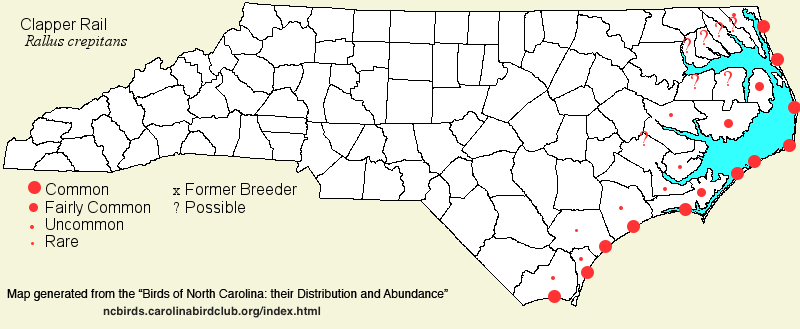 |  |
|
Clapper Rail - Rallus crepitans RALLIDAE Members: | Search Common: Search Scientific: |
|
|
|||||||
| General Comments | The Clapper Rail is, by far, the easiest rail to see in the state and is the most characteristic bird of the tidal salt marshes. Also, it is one of the few rails that regularly calls during daylight hours. It has remained a common to locally very common bird in such marshes for many decades, even with a bit of hunting pressure. Because it is common all year, it is difficult to detect migratory movements; yet, the documentation of a number of birds inland from kills at TV towers or skyscrapers clearly shows that some birds not only migrate southward from the Northeastern coast but also cut across inland portions of the state, if only during the night, with little or no interest in landing until they reach coastal marshes. | ||||||
| Breeding Status | Breeder | ||||||
| NC BRC List | Definitive | ||||||
| State Status | |||||||
| U.S. Status | |||||||
| State Rank | S4 | ||||||
| Global Rank | G5 | ||||||
| Coastal Plain | Permanent resident along the coast (tidal marshes); casual migrant elsewhere. Common to very common, and widespread, in nearly all salt marshes along the coast, including some brackish marshes around ponds and impoundments. Less numerous, though present, in some tidal brackish marshes farther inland, such as along the mainland shore of Pamlico Sound and major rivers. Casual to very rare (eight records) inland migrant in fall, late Aug to mid-Nov, with most records from Wayne. Casual (four records) in spring inland, on 17 Apr, 23 Apr, 23 Apr, and 27 Apr. Accidental in early summer inland, with one photographed at Watson Lake (Moore) on 19 Jun 2022 being exceptional. Peak counts: ? | ||||||
| Piedmont | Very rare transient in the eastern half of the province, but no records yet for the western portions. At least 15 records: records from Raleigh on 13 Apr and 21 Apr (year not given in Pearson et al., 1959); one (specimen dead at TV tower), Raleigh, 28 Sep 1984; one (specimen dead at skyscraper), Charlotte, 26 Apr 2004; one (specimen), Beaverdam Reservoir (Wake), 21 Sep 1987; one juvenile photographed in High Point (Guilford), 29 Aug 2011; one juvenile taken in by a wildlife rehabilitator in Huntersville (Mecklenburg), 17 Sep 2011; one photographed at Jordan Lake (Chatham), 25 Aug 2015; one photographed at Maple View Farm (Orange), 20-22 Sep 2015; one that survived a window collision in downtown Raleigh, 21 Apr 2016; one found moribund in Hickory (Catawba), 5 Sep 2016; one found moribund on a road in Raleigh, 18 Sep 2017; one in a Charlotte yard, 1 Oct 2018; one in an Apex (Wake) parking lot, 20 Sep 2021; and one on the shoreline of Jordan Lake, 18 Sep 2024. | ||||||
| Mountains | No records. | ||||||
| Finding Tips |
The species is easily heard calling at dawn or dusk, and sporadically during the day and night, in most any tidal marsh. To see them, look mainly at low tide, as the birds walk out briefly onto the mudflats. At very high tides, they can be flushed by walking the edge of the water. **** | ||||||
| Attribution | LeGrand[2025-01-29], LeGrand[2023-03-17], LeGrand[2023-03-09] | ||||||
| NC Map Map depicts all counties with a report (transient or resident) for the species. | Click on county for list of all known species. |
| NC Breeding Season Map Map depicts assumed breeding season abundance for the species. |  |